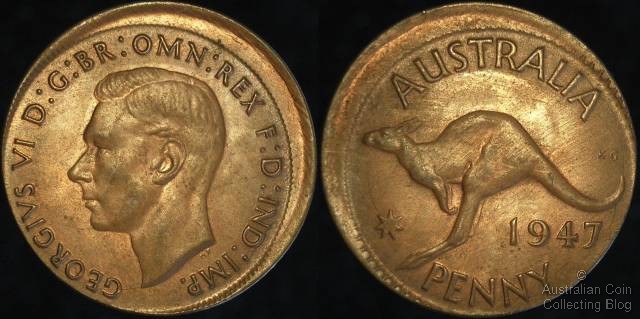September 2008 Archives
 Australia 2002 Outback 1 Dollar $1 Coin Indent Error
Australia 2002 Outback 1 Dollar $1 Coin Indent Error
Interestingly termed, an "Indent" error coin occurs when 2 planchets are fed into the collar accidently at once. Consequently the dies will press the coin blanks together creating a partial blank on one side. This may fully or only partially obscure the design. An indent may occur with the same blank or a totally different shaped or sized blank. This will result in a depression in the lower coin the shape of the upper blank. The above pictured is of the rarer type where a blank of a different denomination was fed into the collar. It is an Australian 2002 Outback design one dollar where a 5 cent (or possibly $2) blank has been fed in simultaneously.
 Australia 1947 Penny Broadstrike Error
Australia 1947 Penny Broadstrike Error
An interesting type of error is the broadstrike. Broadstrikes are coins that have been struck while the coin planchet is totally or partially unconstrained by the collar. The collar is the third major part of the coining process, and normally the blank planchet sits within the collar and when struck the metal of the planchet expands until constrained by the collar. Often this constraint is used to impart a design on the edge of the coin such as reeding.
When the planchet is free to move beyond the normal amount allowed by the coining collar the result is a 'broadstrike'. Typically broadstrikes are thinner than a normal coin and quite a bit wider and not usually round. In addition elements of the design are usually very weakly struck or missing altogether.

Australia 1963 Sixpence Broadstrike
Availability of pre-decimal broadstrikes depends largely on date. Early pre-decimals are very difficult to find broadstruck in any condition. George VI and Elizabeth II pre decimal coins are not too difficult to find, with the copper coins more common than the silver, and the lower denomination silver coins (3d and 6d) more common than the shilling and florin. This is likely to be the case simply because of the much larger mintages of the lower value coins. Some years are more commonly found (such as 1948y half pennies) as broadstrikes, and other years less so (such as 1951PL copper coins), Silver coins struck in the USA during World War II and 1960-64 silver can also be found reasonably easily as broadstrikes.
As normal when collecting any coin you should purchase errors in the best grade that you can afford. Australian Errors are not typically graded when sold but the same sorts of standards used to grade normal circulation coins can be applied. Broadstruck coins in UNC (uncirculated) or even EF (extremely fine) condition are spectacular coins indeed!
There are a few types of Australian coinage that are relevant to this topic. Pre-decimal coins and banknotes. Royal Australian Mint Decimal Issues. Pre-decimal issues ceased to be circulating currency when Australia changed to the decimal system in 1966. Of the RAM issues there are circulating issues that you would find in your change and what we call NCLT 'non-circulating legal tender' issues of banknotes and coins. The Perth Mint also releases coins that are NCLT.
Firstly when thinking about starting a coin collection you must decide where your interests lie, is it for fun or investment? Then maybe you need to consider your budget. Some issues can be very expensive due to rarity, mintage or condition. With that in mind you could start a coin set striving for a coin for every year,denomination, each monarch or a set of error types. The list is endless really with the key being enjoyment. A piece of advice would be when buying choose wisely, research prices and buy the best grade you can afford at the time. Just collecting interesting coins out of your change can be fun and a great way to introduce the kids into the world of collecting.
I've just published the new Australian Florin site that contains the same sort of information about florins that this site does about threepences. Please take a look and let me know if you find any factual errors or if there's any information that needs to be added.


